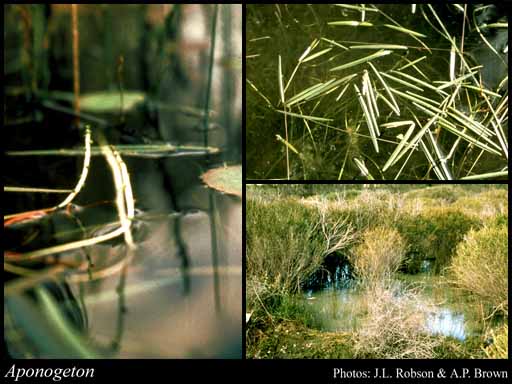- Reference
- Sp.Pl. [Linnaeus] 32 (1782)
- Name Status
- Current

Scientific Description
Family Aponogetonaceae.
Habit and leaf form. Herbs; laticiferous. Perennial. Leaves basal. Cormous, or rhizomatous. Hydrophytic; rooted. Leaves submerged, or floating. Often heterophyllous. Leaves alternate; petiolate; sheathing. Leaf sheaths with free margins. Leaves gland-dotted (with punctae or raised glands; also often with hydropoten (localised regions of flat cells appearing as blitches)); simple. Leaf blades entire; parallel-veined; cross-venulate (the tissue between the veins breaks up as the leaf matures, leaving a network with holes). Axillary scales present. Leaf anatomy. Hairs absent. Stem anatomy. Secondary thickening absent.
Reproductive type, pollination. Fertile flowers hermaphrodite, or functionally male, or functionally female. Unisexual flowers present, or absent. Plants hermaphrodite, or monoecious, or dioecious (rarely). Floral nectaries present. Nectar secretion from the gynoecium (from the sides of the carpels). Entomophilous (some species setting seed while submerged); via beetles, or via hymenoptera.
Inflorescence and flower features. Flowers aggregated in ‘inflorescences’. Inflorescence many-flowered. Flowers in spikes. Inflorescences terminal; simple or once to several times basally divided, borne on an erect, emergent, leafless axis which arises from the axil of every second leaf, usually emergent but sometimes remaining submerged; pseudanthial (sometimes), or not pseudanthial; spatheate (the spathe caducous or rarely persistent). Flowers ebracteate; ebracteolate; small; fragrant, or odourless; usually very irregular; when irregular (i.e. usually), zygomorphic. The floral asymmetry involving the perianth. Flowers cyclic, or partially acyclic. Sometimes the gynoecium acyclic. Perigone tube absent. Perianth of ‘tepals’, or absent; when present, (1–)2(–6); 1 -whorled; free; sepaloid, or petaloid; when present, white (usually), or blue, or pink, or purple, or green to yellow. Androecial members definite in number, or indefinite in number. Androecium 6–18(–50) (i.e. to ‘many’). Androecial members branched (when ‘many’), or unbranched; free of the perianth; free of one another; 2–4 -whorled (usually 3 + 3). Stamens 6(–50); diplostemonous to polystemonous. Anthers dehiscing via longitudinal slits; extrorse, or latrorse; tetrasporangiate. Gynoecium (2–)3–6(–9) carpelled. The pistil 2–9 celled. Carpels isomerous with the perianth, or reduced in number relative to the perianth, or increased in number relative to the perianth. Gynoecium syncarpous; semicarpous (basally and adaxially joined for one-half to two-thirds of their length, separating at maturity); superior. Ovary plurilocular; 2–9 locular. The ‘odd’ carpel anterior. Styles 2–9 (each style short, with a ventral stigmatic groove); free; apical, or lateral (in A. elongatus). Stigmas 2–9; dry type; papillate; Group II type. Placentation basal. Ovules (1–)2–8 per locule; ascending; anatropous.
Fruit and seed features. Fruit non-fleshy; more or less an aggregate. The fruiting carpel dehiscent; a follicle (usually distinctly beaked). Fruit dehiscent. Seeds non-endospermic; with a testa (1 or 2 present); with starch. Cotyledons 1. Embryo chlorophyllous; straight. Seedling. Hypocotyl internode present. Mesocotyl absent. Seedling collar not conspicuous. Cotyledon hyperphyll elongated; assimilatory; dorsiventrally flattened. Coleoptile absent. Seedling non-macropodous. Seedling cataphylls absent. First leaf dorsiventral. Primary root ephemeral.
Geography, cytology, number of species. Native of Australia and adventive. Not endemic to Australia. Australian states and territories: Western Australia, South Australia, Northern Territory, Queensland, New South Wales, and Victoria. Northern Botanical Province and South-West Botanical Province. A genus of 50 species; 3 species in Western Australia; 2 endemic to Western Australia.
Economic uses, etc. Some aquarium and watergarden ornamentals, food from the tubers.
Additional comments. Aponogeton proliferous is proliferous (inforescences producing plantlets), only rarely flowering. Some species are cleistogamous.
Les et al. (2005) described Section Viridis whose only member is A. hexatepalus, a species without close relatives. Aponogeton elongatus and A. kimberleyensis were placed in Section Flavida Subsection Flavida.
Additional characters Petals uninerved, or multinerved. Fruit rostrate.